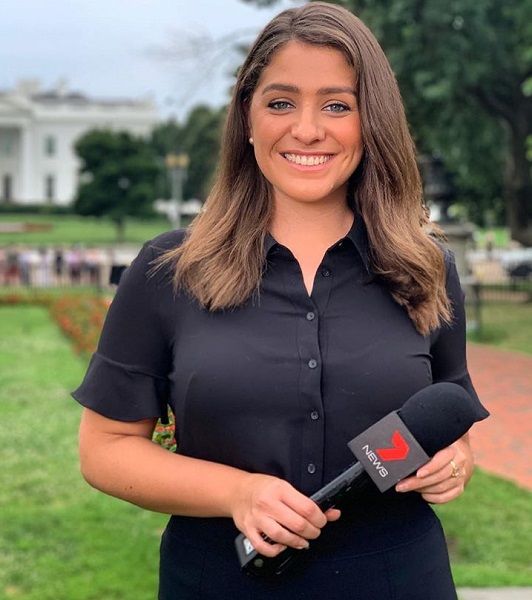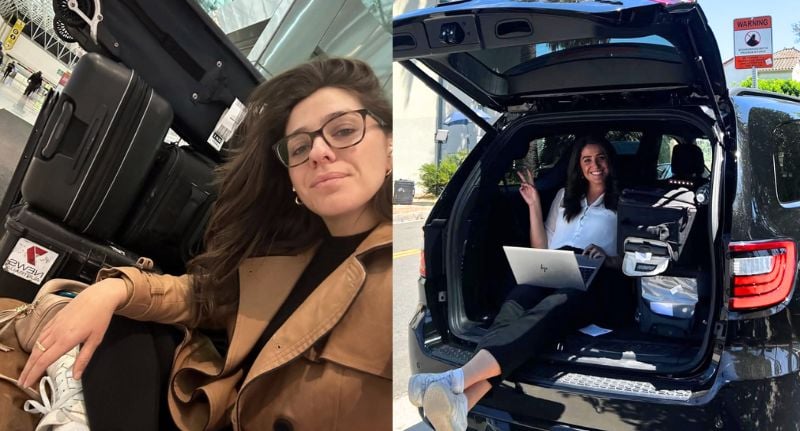In the shadow of one of the most explosive celebrity trials in recent memory, 7NEWS reporter Mylee Hogan is stationed outside a Manhattan courthouse, mic in hand, waiting for a flash of action.
It could be Sean ‘Diddy’ Combs stepping through the doors or a prosecutor gliding past. It could be a fan, a protester, or a TikTokker angling for a clip to go viral.
Suffice to say, this is not your standard court beat.
“Sean ‘Diddy’ Combs is someone who took hip hop and made it mainstream,” Hogan told Mediaweek after a long day of reporting. “He’s well known, not just in America, but throughout the world. He has been extremely successful. And now he’s facing these federal charges, including racketeering and sex trafficking, and he’s facing life in prison.”
It’s the kind of high-stakes, high-profile story that shapes global headlines. For Hogan, it also sets the tone for her every waking hour.

Mylee Hogan on the tools in her role as the Seven Network’s US Correspondent
The case that has gripped the world
To say there’s public interest in this case is an underselling it.
“I haven’t seen, when I’ve covered cases in Australia, as many just everyday people turning up to go into the courtroom and watch,” Hogan says.
Combs is accused of orchestrating sexual ‘freak-offs’, as he allegedly called them, involving women whose participation is now under legal scrutiny. The prosecution argues these weren’t consensual but coerced, with singer Cassie Ventura, Combs’ former partner, revealing sordid details on the stand.
“There’s so much interest in this case because of who he is as a celebrity and the details of the case,” Hogan says. “That will be what the jury has to weigh up, were these ‘freak-offs’ consensual, or were women coerced?”
The stakes, the personalities, and the salacious details have turned the courthouse into a theatre of obsession. But it’s not just the nature of the case pulling people in. It’s also the changing media landscape.
“There’s traditional media, there’s TikTok, and everyday people are recording as well,” Hogan explains. “So there’s so much interest generated. It feels like sometimes people look at it as entertainment.”

Sean ‘Diddy’ Combs
Pre-dawn prep and paper trails
Before Hogan steps into that media scrum, she’s already been on the job for hours. Her preparation is meticulous. For a story this big, with lawyers, prosecutors, and witnesses moving fast and unpredictably, she has to be across every aspect.
“I’ve got to be very prepared,” she says. “I’m watching all the documentaries that are out there. I watch a lot of different news reports in the lead-up, reading widely, going through whatever material is available to ensure I’m across all of the details.”
And it’s not just names and dates. It’s faces.
“It is essential to ensure you know all those players… because we work in television. So when a prosecutor walks past you, especially for a court case, that could be my only shot of the day – my fresh shot of the day.”
By the time most of Australia is waking up, Hogan has already done her first scan of headlines, sifted through overnight developments, and then it’s straight down to court.
Campouts, placeholders and the theatre of American justice
Covering a court case in the US, especially one involving a global celebrity, is a different kind of spectacle.
“In this particular court, there are overflow rooms. It’s so busy that before the first day, people camped out in front of the courtroom to ensure they could get inside and take a seat.”
Some even turned the queue into a hustle.
“Some people run a business, like little businesses down here, where you can pay them money to hold your spot in the line. People will wait there with signs saying, ‘I’ll take this much money to hold your spot.’”
In other words, if you’re a reporter needing to do a live cross for breakfast TV, you might actually pay someone to keep your courtroom seat warm.
Then there’s the gear. Camera operators arrive before dawn to claim their spot. Tripods are planted like flags in a media frontier. There’s also a code, an unspoken, often unacknowledged, but widely respected one.
“It can definitely get competitive among the cameramen and the photographers to get the best shots,” Hogan admits. “But generally speaking, everyone’s respectful and everyone knows the game. So they know how to work together.”

(L-R) The queues outside the court and the camera operators gathering outside to capture the ‘perfect shot’
No phones, no shortcuts, just pen and paper
The courtroom itself has strict rules. No phones allowed.
“It’s old-school pen and paper only, which I don’t love in this day and age because I prefer to be able to type out everything that’s happening,” Hogan says. “But I’ll still write it all out and then come out and start live crossing into Sunrise.”
Picking the right moments matters. There’s the courtroom testimony, and then there’s the punchy grab that tells the audience something essential, or elicits a visceral response.
“It’s a natural reaction when you’re listening to someone give testimony… when you think, oh wow, that is probably what other people’s response will be as well,” Hogan explains. “So I pick out those grabs or those moments because they’re the most impactful.”
But the process doesn’t end there.
“I will always bounce things off a producer. They are crucial in this industry because they’re a second head helping you pick out what’s interesting. You need someone to talk through the information with. A team is always better than one person.”
By sundown, the day is done… sort of
After Sunrise crosses, courtroom notes, and collaborative edits, Hogan wraps her final pieces by 6pm. And then it starts again.
This job is not for the faint-hearted.
“I’m always up early. And the first thing I do is check my phone, which I don’t know if that’s healthy, but I check my phone to make sure I’m up to date.”
She’s half a world away from home, reporting on one of the most sensational trials of the decade. And still, her approach is grounded in something deeply practical: a healthy respect for the craft, the hustle, and the people who make it happen.
“It’s a process and a real team effort.”
In the frenzy of flashing lights and legal drama, Hogan and her crew are calmly, persistently telling the story. Not just of a fallen music icon, but of a media moment, messy, fascinating, and very much unfolding in real time.
